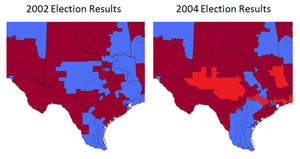2003 Texas redistricting
On June 28, 2006, the Supreme Court upheld the statewide redistricting as constitutional, with the exception of Texas's 23rd congressional district, which it held was racially gerrymandered in violation of Section 2 of the 1965 Voting Rights Act, apparently to try to protect a Hispanic Republican representative.There, Republican incumbent Henry Bonilla was forced into a December run-off after a jungle primary; he lost to Democratic challenger Ciro Rodriguez.[1] After a protracted partisan struggle, the legislature enacted a new congressional districting map, Plan 1374C, introduced in the Texas House by Representative Phil King of Weatherford.On June 28, 2006, the Supreme Court of the United States issued an opinion that threw out one of the districts in the plan as a violation of the 1965 Voting Rights Act because of racial gerrymandering.In September 2001, then House Majority Whip Tom DeLay (TX-22) organized Texans for a Republican Majority (TRMPAC), a political action committee designed to gather campaign funds for Republican candidates throughout Texas—in particular with an eye to gaining control of the state House Speakership, then held by Democrat Pete Laney.But in the summer of 2003, Governor Rick Perry called a series of special legislative sessions in order to continue the redistricting effort.With control of more than one-third of the seats in the State Senate, the Democrats invoked a two-thirds rule, preventing a vote on the redistricting plan during the first special session.But in December 2005, The Washington Post reported, "Justice Department lawyers concluded that the landmark Texas congressional redistricting plan spearheaded by Rep. Tom DeLay violated the Voting Rights Act, according to a previously undisclosed memo," uncovered by the newspaper.[9] The document, endorsed by six Justice Department attorneys, said [T]he redistricting plan illegally diluted black and Hispanic voting power in two congressional districts ...[9]In addition, according to the Post, Justice Department lawyers "found that Republican lawmakers and state officials who helped craft the proposal were aware it posed a high risk of being ruled discriminatory compared with other options".While the Court said states are free to redistrict as often as desired, the justices ruled that Texas's 23rd congressional district was invalid, as it violated Section 2 of the 1965 Voting Rights Act by racial gerrymandering.



DemocraticRepublicancongressional districts2004 electionsRepublicansReconstructionDemocratsTexas LegislatureUnited States Supreme CourtLeague of United Latin American Citizens v. PerryTexas's 23rd congressional districtracially gerrymanderedVoting Rights ActHenry Bonillajungle primaryCiro RodriguezTexas state legislatureHouse of RepresentativesPhil KingWeatherfordracial gerrymanderingAnn RichardsGeorge W. BushRick PerryTexas ConstitutionTom DeLayHouse Majority WhipTexans for a Republican Majoritypolitical action committeePete LaneyAmericans for a Republican MajorityJim Dunnamquorumquorum-bustingtwo-thirds ruleAlbuquerque, New MexicoJohn WhitmireThe New YorkerJeffrey ToobinJohn CornynTexas MonthlyRoberto R. AlonzoDallasKevin E. BaileyHoustonLon M. BurnamFort WorthCorpus ChristiJoaquín CastroSan AntonioGarnet F. ColemanEagle LakeYvonne DavisJoseph D. (Joe) DeshotelBeaumontDawnna M. DukesAustinJames R. (Jim) DunnamA. Craig EilandGalvestonDan EllisHuntsvilleJuan M. EscobarKingsvilleDavid L. FarabeeWichita FallsJessica Cristina FarrarPete P. GallegoAlpineEagle PassRyan GuillenRio Grande CityL. Scott HochbergMark S. HomerCharles L. Hopson 2dJacksonvilleJames E. (Pete) LaneyHale CenterJohn P. Mabry, Jr.F.F. (Trey) Martinez Fischer 3dRuth Jones McClendonJames M. (Jim) McReynoldsLufkinJosé A. MenéndezPaul C. MorenoEl PasoElliott NaishtatRichard J. (Rick) NoriegaRene O. OliveiraBrownsvilleDora F. OlivoMissouri CityL. Aaron Peña, Jr.EdinburgJoseph C. (Joe) PickettTornilloRichard E. RaymondLaredoAllan B. RitterNederlandEduardo R. (Eddie) RodriguezPatrick M. RoseDripping SpringsHarlingenBarry B. TelfordDeKalbSenfronia P. ThompsonCarlos I. UrestiMichael U. VillarrealWeslacoSteven D. WolensGonzalo BarrientosRodney EllisMario GallegosJuan "Chuy" HinojosaMcAllenEddie Lucio, Jr.Frank MadlaEliot ShapleighLeticia Van de PutteRoyce WestJudith ZaffiriniTravis County, Texaspre-clearanceVoting Rights Act of 1965The Washington Post